BISC 101: Plant Biology
1/96
There's no tags or description
Looks like no tags are added yet.
Name | Mastery | Learn | Test | Matching | Spaced |
|---|
No study sessions yet.
97 Terms
Part 1:
Root System
- Below ground portion
- Anchors the pant and takes in water and nutrients from the soil
- grows throughout it's life
Shoot System
- Above ground portion
- harvests light and CO2 from the atmosphere to produce sugar
- grows throughout it's life
Importance of SA/Volume in plants
- Plant is more efficient at absorbance-and-synthesis when it has a large SA compared to volume (leaves are flat)
Root System:
Taproot & Lateral Roots
Taproot: vertical roots that go straight down into the soil, rather long and thick structure (10)
Lateral: run horizontally in the soil (7)
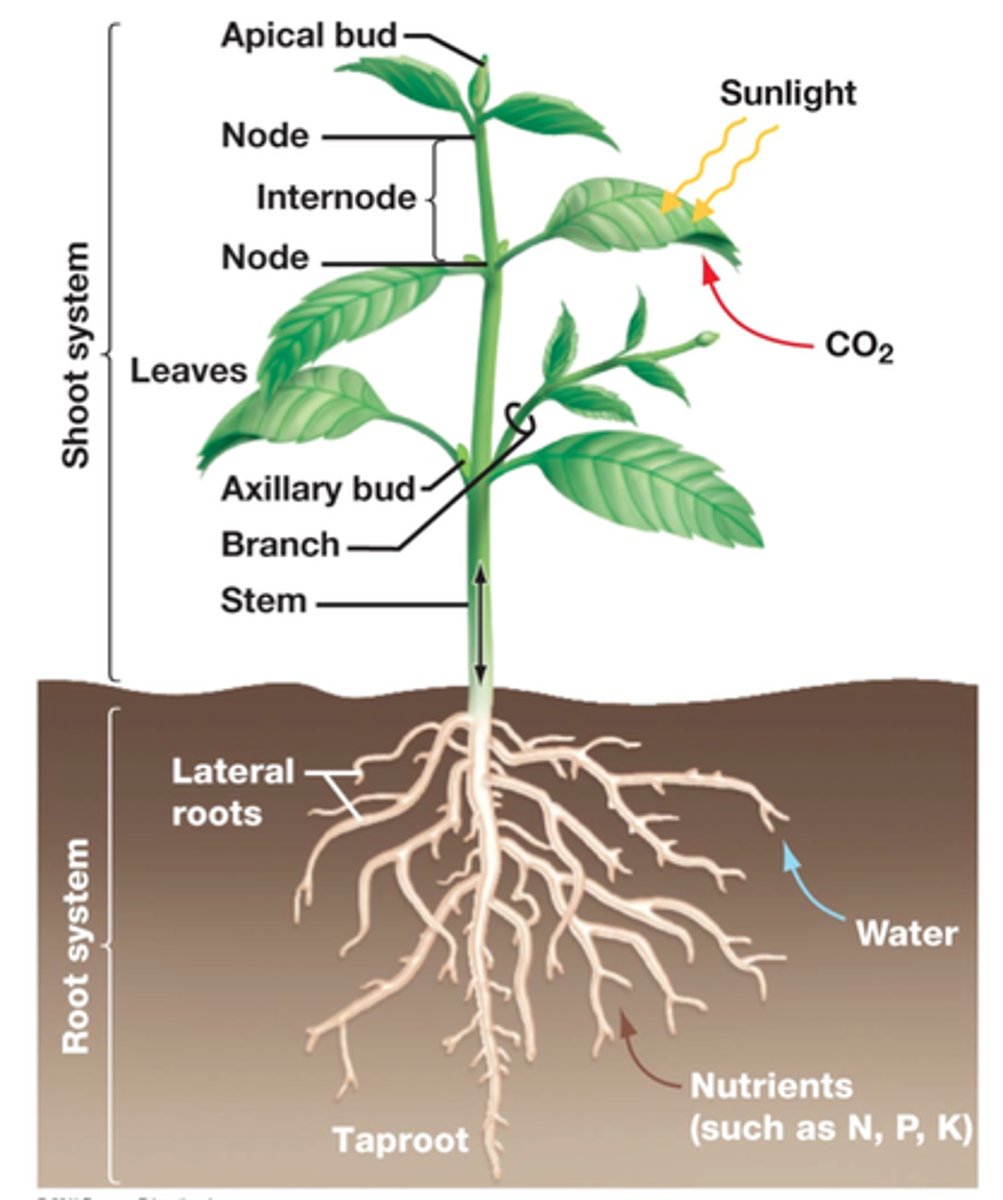
Shoot System:
1. Stems
2. Stem: nodes
3. Stem: internodes
1. Stems: vertical structure of plant
2. Nodes: where leaves are attached
3. Internodes: segments between nodes
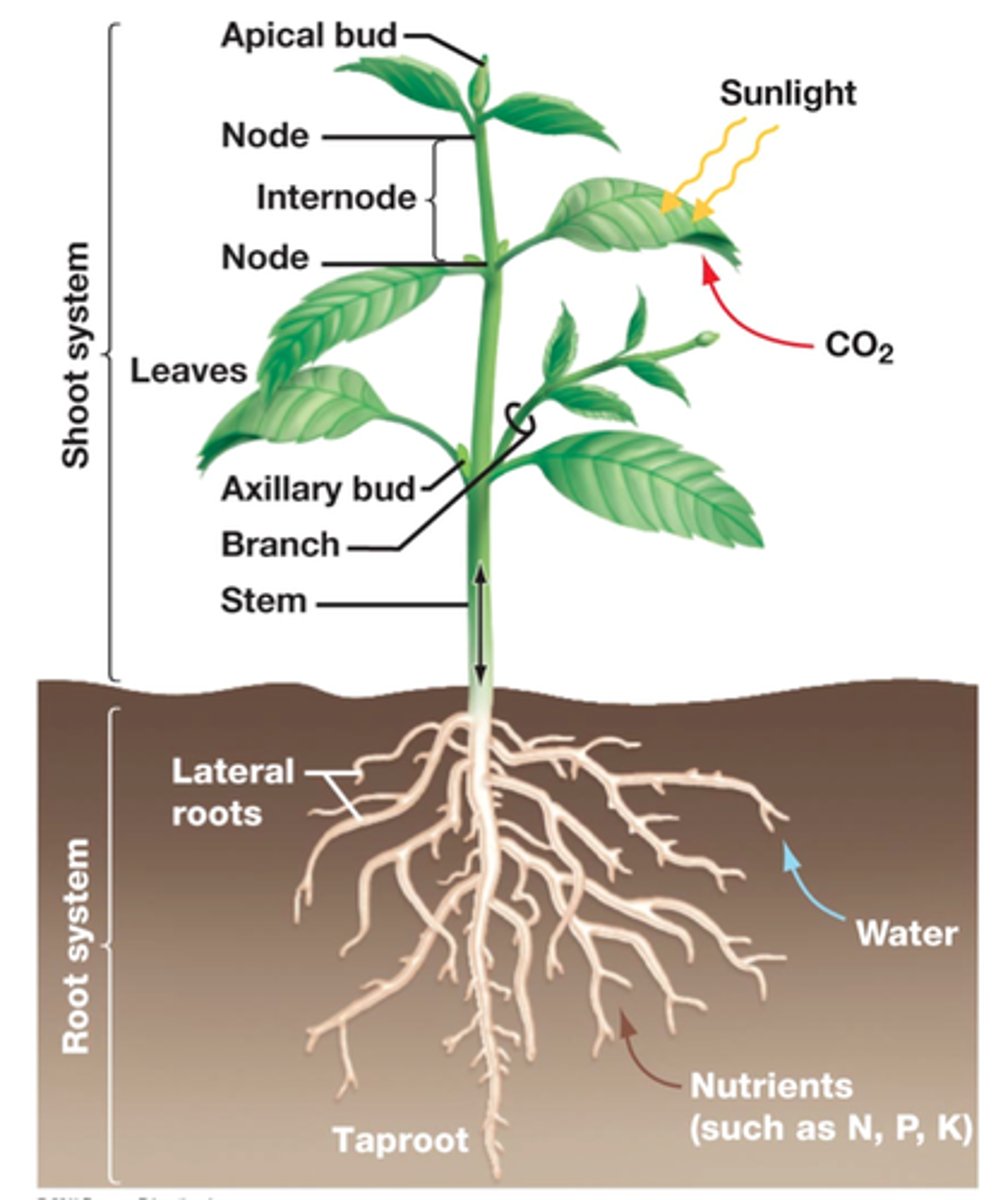
Shoot System:
4. Leaf
5. Axillary (lateral) buds
4. Leaf: Photosynthetic Organ of plant
5. Axillary buds: the nodes where leaves attach to the stem

Shoot System:
6. Branch
7. Apical bud
6. Branch: an axillary bud that has grown and extended from stem
7. Apical bud: tip of each stem and branch where growth occurs
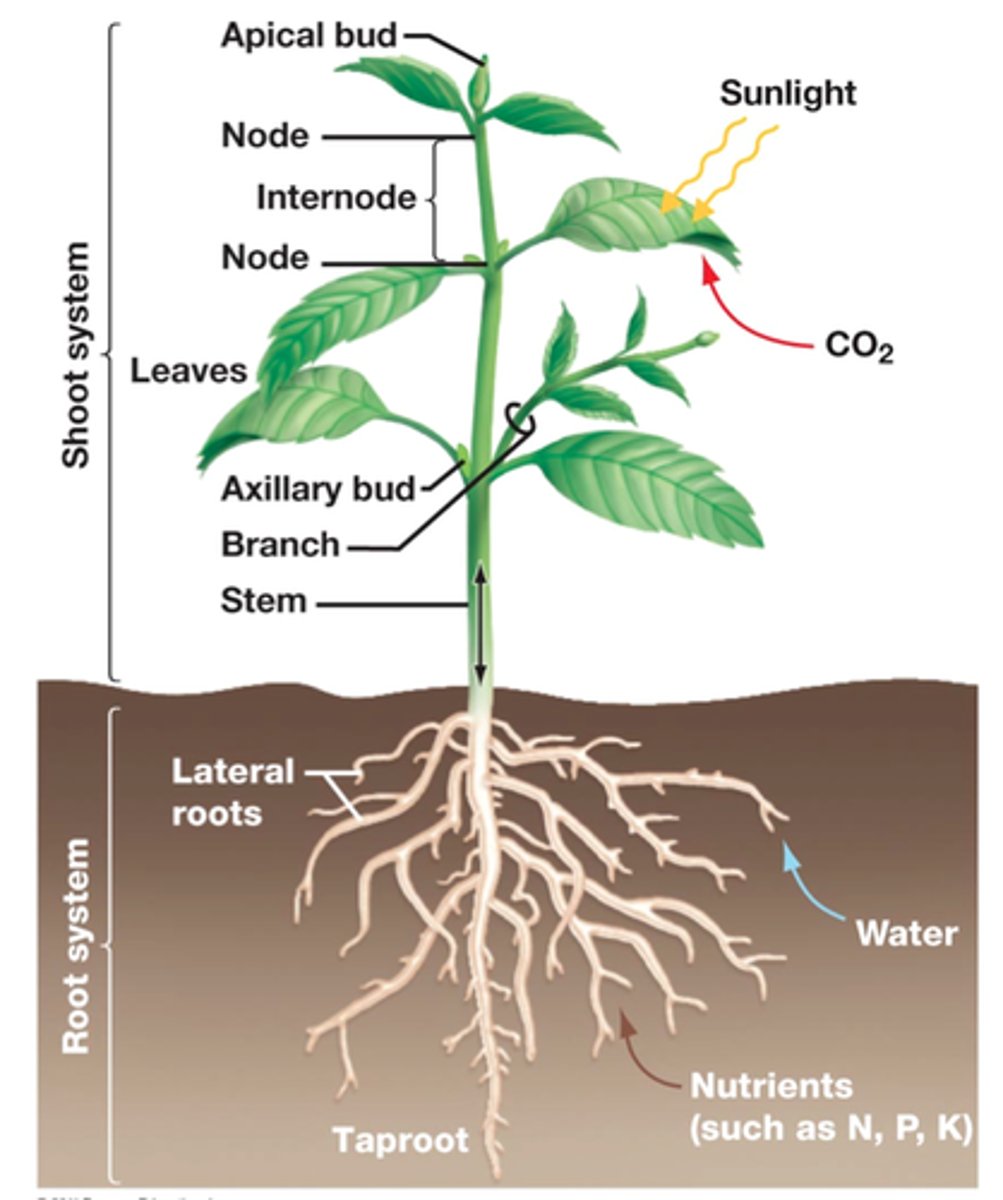
The Leaf Function
- The leaf has a very large SA.
- Has hundreds of thousands of leaves
- This large SA promotes absorption of photons to support photosynthesis
Leaf is composed of:
1. Blade
2. Petiole
1. Blade: The large flat portion of the leaf
2. Petriole: Attaches blade to axillary bud

Define:
1. Meristem
1. Meristem: populations of undifferentiated cells that retain the ability to undergo mitosis and produce new cells.
Primary Growth
The process of lengthening of the root and shoot system. Cells that are derived from the apical meristems form the primary plant body
What are the three types of tissues(cells) in plants?
1. Protoderm: gives rise to dermal tissue system.
2. Ground meristem: gives rise to ground tissue system, which makes up the bulk of the plant.
3. Procambium: gives rise to the vascular tissue system
Where is apical meristem found?
Located at the tip of each root and shoot.
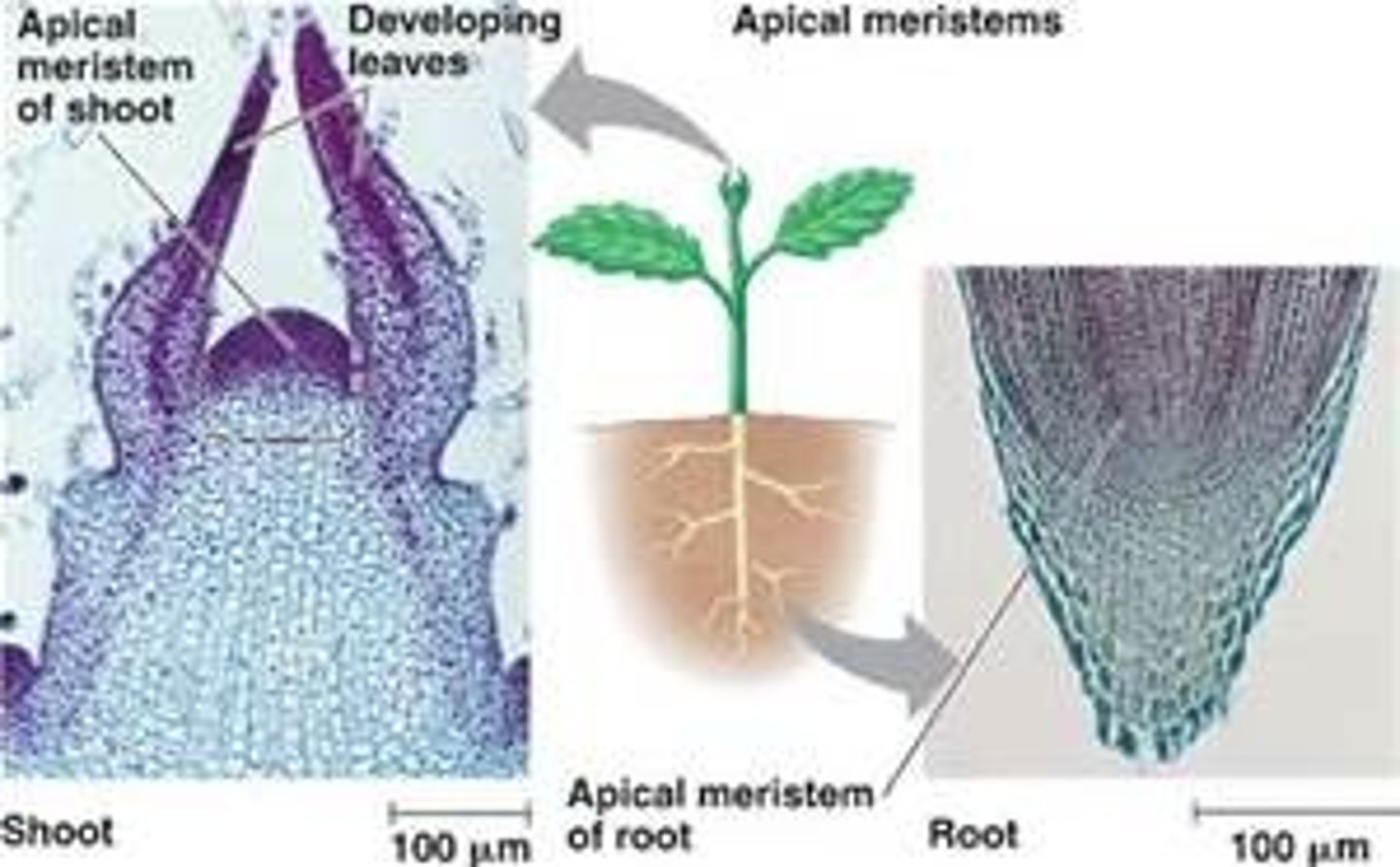
What is the role of the apical meristem?
As cells in apical meristems divide, enlarge, and differentiate, roots and shoot tips extend the plant body outward, allowing it to explore new space.
Tissue systems (define)
1. Dermal Tissue
2. Ground Tissue
3. Vascular Tissue
1. Dermal: is a single layer of cells that covers the plant body and protects it
2. Ground: makes up bulk of plant, is responsible for photosynthesis and storage
3. Vascular: which provides support and transports water, nutrients, and photosynthetic products between root and shoot system
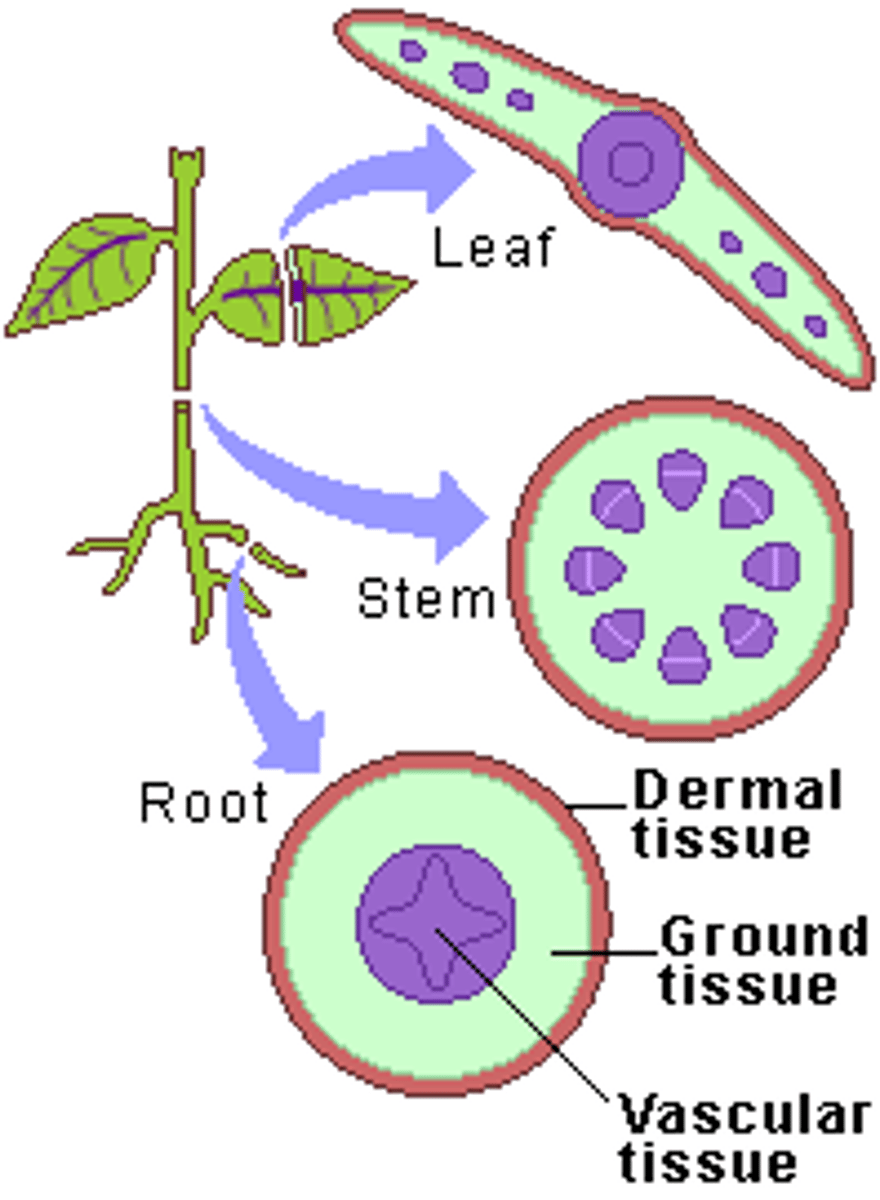
How are these tissues organized in roots, shoots, and leaves?
Dermal is the outermost layer of tissue. Ground tissue makes up most of the space inside the plant and encases the Vascular tissue.
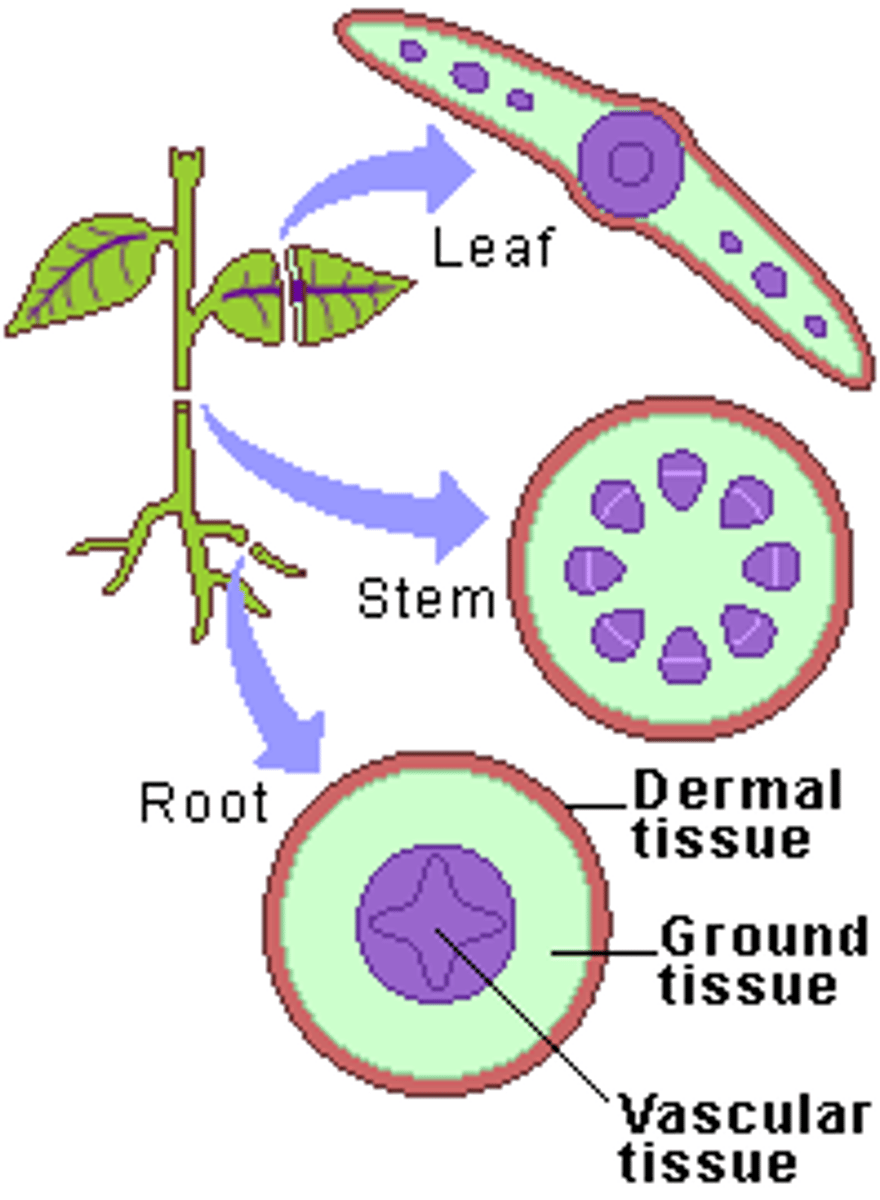
Define:
1. Vascular Bundle
2. Pith
3. Cortex
4. Plasmodesmata
1. Vascular Bundle: a cluster of xylem and phloem in plant stem
2. Pith: ground tissue in the vascular bundle
3. Cortex: layer of ground tissue outside vascular bundles
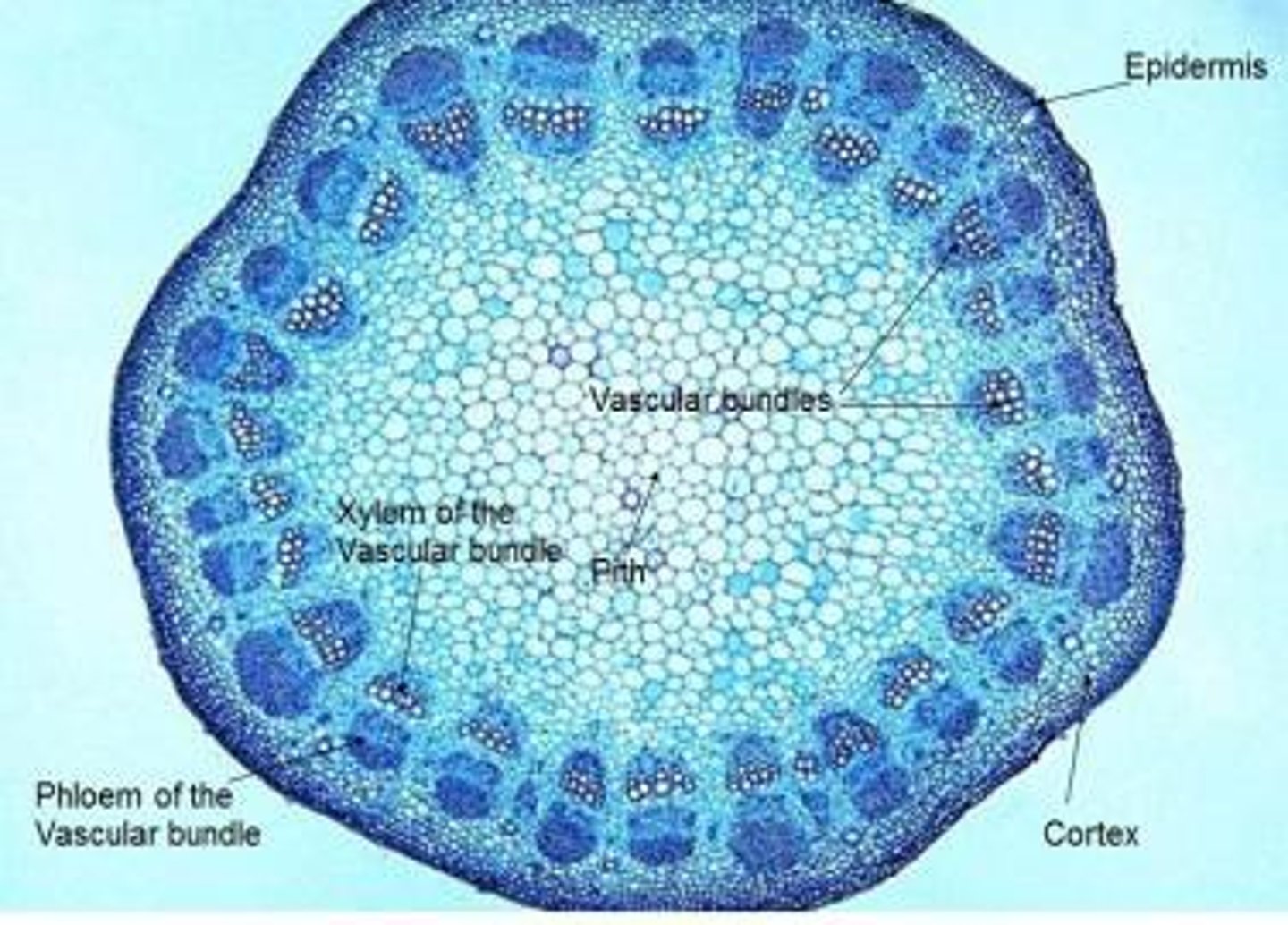
Plant cell Features
1. Cell wall: rigid structure that surround membrane and is composed of cellulose
2. Plasmodesmata: connects cytoplasm of adjacent plant cell. Consists of cytoplasm and smooth ER
3. Chloroplasts: site of photosynthesis
4. Vacuole: large storage area for water and nutrients. Stores cell sap
Dermal Tissue Functions
- separates internal and external environment
- protect plant body: water loss, disease, animal
Dermal Tissue Cell types:
1. Epidermal cells
- composes most of this tissue system
- lack chloroplasts
- in roots responsible for absorbing water and nutrients
- protective role: secrete cuticle a waxy layer that protects surface of plant from organism.
- Cuticle is very hydrophobic and reduces water loss via evaporation.

Dermal Tissue Cell types:
2. Stoma
- regulate gas and water exchange
- 2 guard cells shape to open or close the stoma
- Open: H20, CO2, and O2 move between atmosphere and inside cell
- Stoma open when CO2 is needed

Dermal Tissue Cell types:
3. Trichomes
- hair like cells
- found in shoot system
Fxn:
1. Keep leaf surface cool by reflecting sunlight
2. Reduce water loss
3. Provide barbs or store toxins
4. Trap and digest insects

Ground Tissue Functions
Where most photosynthesis and carbs storage occurs
Ground Tissue Cell types:
1. Parenchyma cells
- most abundant plant cell with thin cell walls
- In leaves the cells are filled with chloroplasts
- In other plant organs they store starch
- they are totipotent: the ability to divide into a new plant (asexual)

Ground Tissue Cell types:
2. Collenchyma cells
- varying cell wall thickness, cell is longer than thinner than most plant cells
- supports plant body
- cell have ability to stretch and elongate

Ground Tissue Cell types:
3. Sclerenchyma cells
- produce thick secondary cell wall
- new secondary cell wall is more rigid because of compound lignin
Two Types:
1. Fibres: elongated
2. Sclereids : short
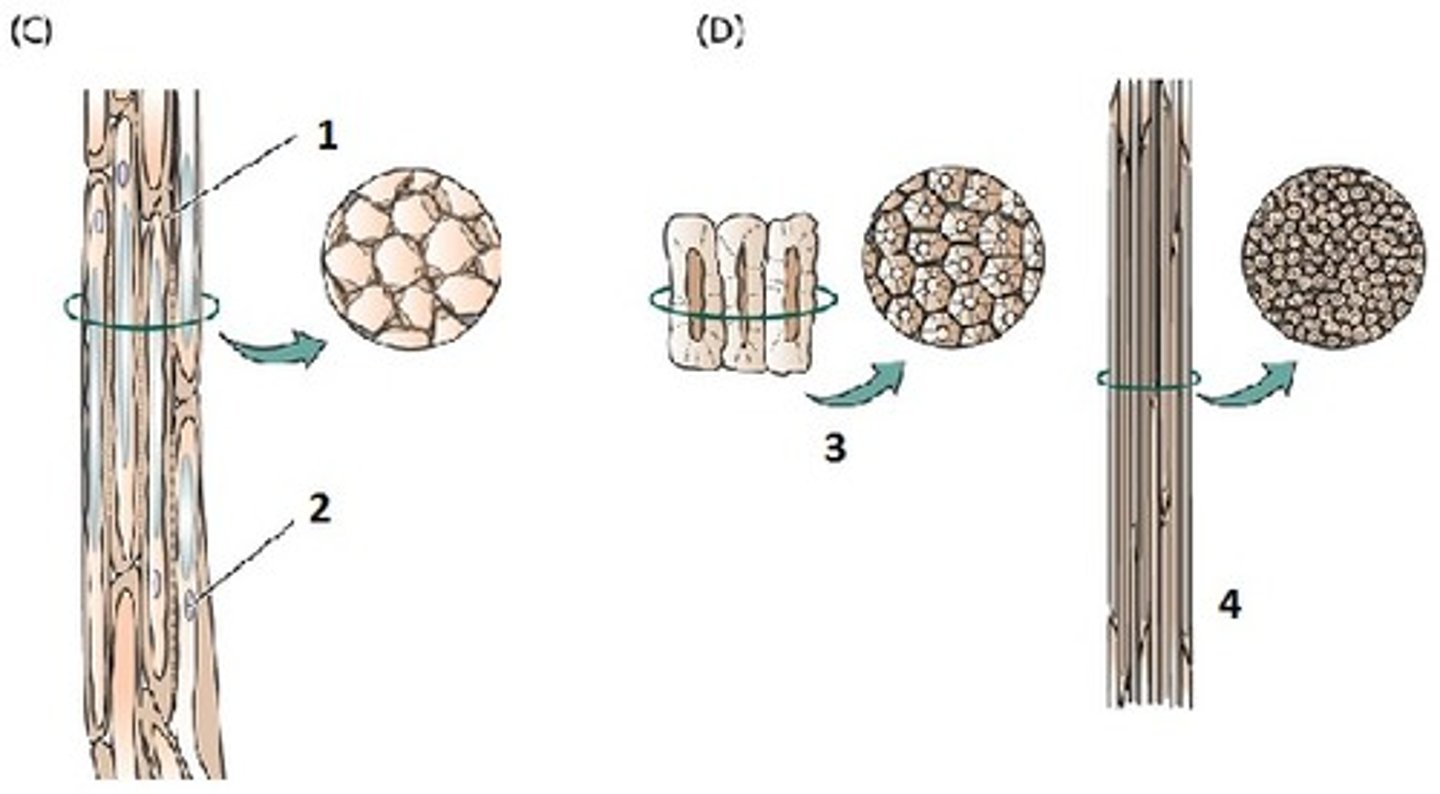
Vascular Tissue Functions
Functions in support and long distance transport of water and nutrients. Move products made and stored in ground tissue
Vascular Tissue Cell types:
1. Xylem Tissue (contains 2 cell types)
Fxn: conducts water and dissolved ions in 1 direction. From root to shoot system
1. Tracheids: water conducting cells
2. Vessel Elements: conduct water efficiently in angiosperms

Vascular Tissue Cell types:
2. Phloem Tissue (contains two 2 specialized parenchyma cells)
Fxn: conducts sugar, amino acids chemical signals in 2 directions: roots to shoots and shoots to roots.
1. Sieve-tube members: Responsible for transporting sugar and nutrients
2. Companion cells: provide material to maintain cytoplasm and cell membrane of sieve-tubes.
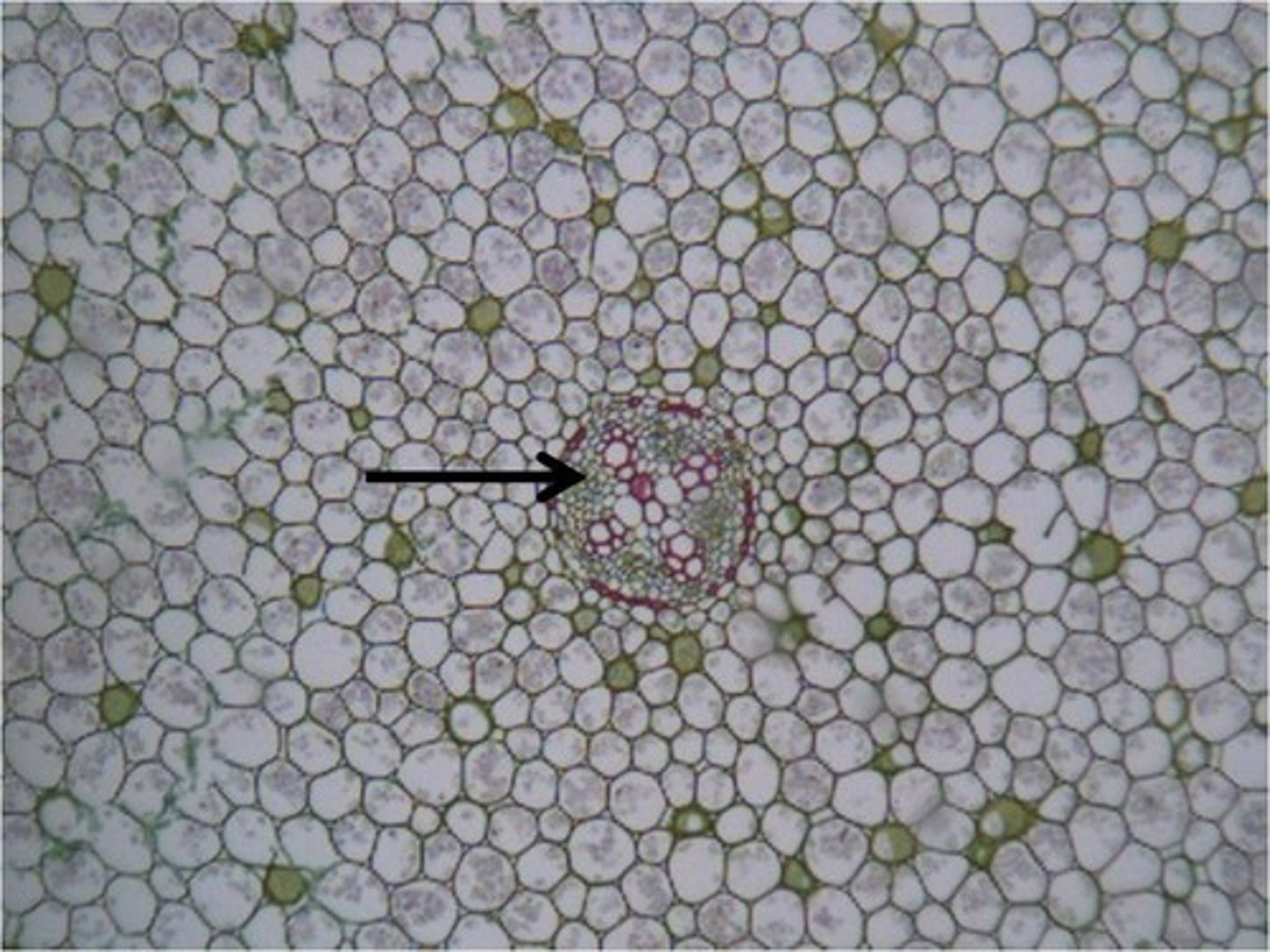
What is the difference between primary and secondary growth?
- Primary growth increases length of roots and shoots. Extension of root and shoot system is to increase plant's ability to absorb photons.
- Secondary growth increases the width of plant body. This increases amount of conducting tissue available and prove the structural support required for extensive primary growth
What is cambium?
- Is a secondary meristem.
- Secondary growth produce wood and occurs in species where cambium is present

How is cambium different or similar to apical meristem?
- Cambium increases width, meristem increases height
- Cambium runs down length of root, meristem is located at the tip root and shoot
What are the five tissue types of secondary growth?
1. Cork
2. Cork Cambium
3. Phelloderm
4. Phloem
5. Xylem
What types of cells make up these tissue types?
What are their functions?
Where are they located in roots, shoots, and leaves?
1. Bark
1. Cork: made of cork cells and protect plant
2. Cork Cambium: made of meristematic cells and produce cork and phelloderm
3. Phelloderm: made of parenchyma cells and used in synthesis and storage
2. Secondary phloem
4. Phloem: made of parenchyma cells (sieve tube & companion cells) and sclerencyma cells (fibres, sclerids)
- Fxn transport of nutrients
- Produce bark
3. Secondary xylem
5. Xylem: made of trachieds, vessels, parenchyma cells, and sclerenchyma cells (fibres)
- Fxn transport of water and ions
- Produce wood
How do tracheids differ from vessel elements, in addition to their overall shape?
In tracheids, water flows from cell to cell primarily through gaps in the secondary cell wall called pits.
Part 2:
What elements are required for plants to be able to synthesize the 4 macromolecules?
1. Nucleic acids: Nitrogen, Phosphorus (ATP)
2. Carbs: Carbon, Hydrogen, Oxygen
3. Lipids: Oxygen, Carbon, Hydrogen
4. Protein: Sulphur
What chemical do plants use to make up most of their mass?
1. carbon dioxide 45%
2. Oxygen 45%
3. Hydrogen 6%
What is an essential nutrient?
1. It is required for normal growth and reproduction- meaning that the plant cannot complete its life cycle without nutrition
2. It is required for a specific structure or metabolic function
What are their three categories?
1. Obtained from H20/CO2
2. Obtained from soil: macronutrients
3. Obtained from soil: micronutrients
Why are root hairs advantageous for plants?
They increase the SA available for nutrient and water absorption
Explain Nutrient uptake in plants, briefly
- ion, small molecs, and even large molecs pass through cell wall freely
- In contrast, plasma membrane is highly selective
- plasma membrane proteins allow for polar molecules to enter the cell
In a plant cell, which side has more of a negative charge: the inside or the
outside?
- Outside = positive
- Inside = negative
3 steps ions take to enter plant roots
1. Proton Pump
1. Proton pumps out H+ out of the cell to create a electrochemical gradient (+) on outside, (-) on inside.
3 steps ions take to enter plant roots
2. Cation movement
2. Because of the difference in membrane potential (+) on outside & (-) on inside, Promotes movement of cations (+) into the cell via protein channels
3 steps ions take to enter plant roots
3. Anion movement
3. Anions must move against their electrical and chemical gradient. Cotransports assist in this, protons follow their electrical/chemical gradient in the cell and bring in an anion with them.
What are mycorrhizae?
EMF= ectomycorrrhizal fungi, ecto= outside
AMF= arbuscular mycorrhizal fungi,arbor= tree
Fungi that live on plant roots in a symbiotic relationship
What nutrients do mycorrhizae provide to plants? What benefit do mycorrhizae get out
of the deal? Why are these nutrients important to plants?
- EMF/AMF transfer nitrogen and phosphorus from spoil to plant roots, in exchange EMF/AMF get sugar and photosynthetic products
- These nutrients are needed for synthesis of proteins and nucleic acids
What are the 3 main ways that ions are
excluded from cells?
1. Passive exclusion: casparian strips allow endodermal cells to act as a selective filter- preventing ions from entering cell
2. Active exclusion via metallothioneins: methothioneins bind to metal ions and prevent them from acting as poison.
3. Active exclusion via antiporters: Proteins in tonoplast membrane allow plants to actively remove toxic substances from cytosol and store them in the vacuole.
4. Active exclusion via membrane proteins pumping out ions
Nutrient Adaptation of Plants:
1. Epiphytic plants "upon plants"
-They grow on trees and don't absorb nutrients from soil
- They have watering capturing structures
- This structure allows them to capture rainwater, dust, and particles to obtain their nutrients
Nutrient Adaptation of Plants:
Parasitic plants
- They grow in close proximity to other species of plants
- Indian Pipe Doesn't have chlorophyll. Instead it grows onto other trees and obtains sugar and nutrients from mychorrhizal fungi which have obtained sugars from surrounding trees
Nutrient Adaptation of Plants:
Carnivorous plants
- Obtain nutrients like nitrogen from other living organisms. Using structures to capture them then externally digest them.
What is transpiration?
Loss of water via evaporation from aerial parts of the plants (leaves). 2 conditions
1. stomata are open
2. Air surrounding leaves is drier than air inside leaves
What is water potential
The movement of water from areas to high potential to areas of low potential
What are the two components of water potential?
1. Solute Potential: tendency of water to move via osmosis to areas with higher [solute]
2. Pressure Potential: tendency of water to move in response to pressure. Cell walls have a mechanism that prevents the cell from bursting. The cell wall resists expansion of the cell by pushing back (Turgor Pressure), this prevents more water from entering the cell.
What is the difference between part a and part b of this figure? What do the blue arrows mean? What do the yellow arrows mean? Why is the bottom cell turgid and the top cell flaccid?
a. the movement of water
b. blue= water movement
c. yellow= water pressure
d. top cell the water potentials differ. bottom cell the water potentials are equal

Notice the relative values of water potential in the plant and in its environment (soil and air). Explain where water is traveling
Water flows upward due to the low water potentials relative to the high water potentials in soil.
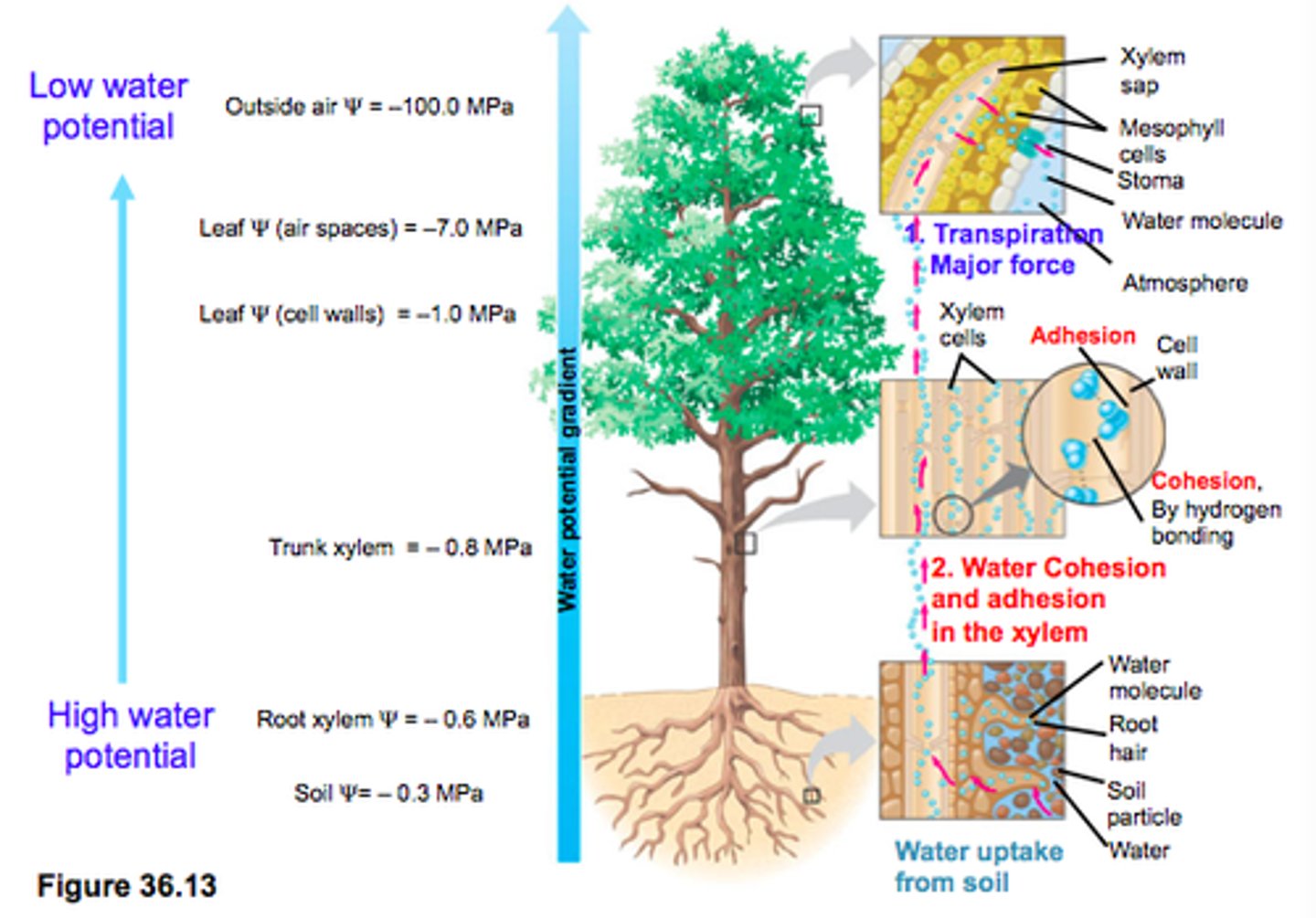
What is the cohesion-tension theory?
Explanation of long-distance water movement in vascular plants, which states water is pulled to the tops of trees along a water-potential gradient, via forces generated by water tension caused by cohesion.
"Water transport is solar powered." What
does this mean?
- plant doesn't use energy to create pulling force (tension)
- The force is generated by energy from the sun, which drives evaporation from the leaf surface. Which, creates a lower water potential.
explain the process by which this transport happens.
1. Water diffuses: inside leaf, the area not occupied by cells is filled with moist air. Water diffused from inside of leaf to atmosphere (evaporates)
2. Water evaporates: as water exists the leaf, the humidity of the spaces inside the leaf drops, causing water to evaporate from menisci that exists at the air-water interfaces
3 Water is pulled out of xylem: the resulting tension created at the menisci pulls water that surrounds nearby cells which in turn pulls water out of the xylem.
4. Water is pulled up xylem: tension is transmitted from water in leaf xylem through stem all the way to root xylem by cohesion
5. Water is pulled out of root cortex: tension pulls water from root cortex cells into root xylem
6. Water is pulled out of soil: tension pulls water from soil into roots
Why is it a challenge for plants to simultaneously acquire CO2 and
prevent water loss? What are some adaptations that may help solve this?
- Plants open stomata to bring in CO2, but water is lost when this occurs
- Plants have a waxy later which minimizes water loss from cells that are directly exposed to sunlight
- Epidermis is thicker in species in dry environments to reduce water loss from parenchyma cells
What is translocation?
movement of sugars throughout a plant specifically from sources like sinks
What is a 'source'? What is a 'sink'?
Source: a tissue where sugar enters the phloem
Sink: a tissue where sugar exits the phloem
- Sources contain high concentration of sugar; sinks have low concentrations of sugar
Where do sources and sinks occur in plants?
- During growing season: sources are leaves and budding leaves and roots are the sinks (also, flowers and fruit)
- Early in growing season: after winter or dry season, sugars move from storage areas to growing areas. Storage cells in roots act as sources; developing leaves act as sinks.
What does a sieve tube member do? What do
companion cells do?
Sieve: plates with channels in them that connect adjacent cells cytoplasm
Companion: cells that support sieve tubes
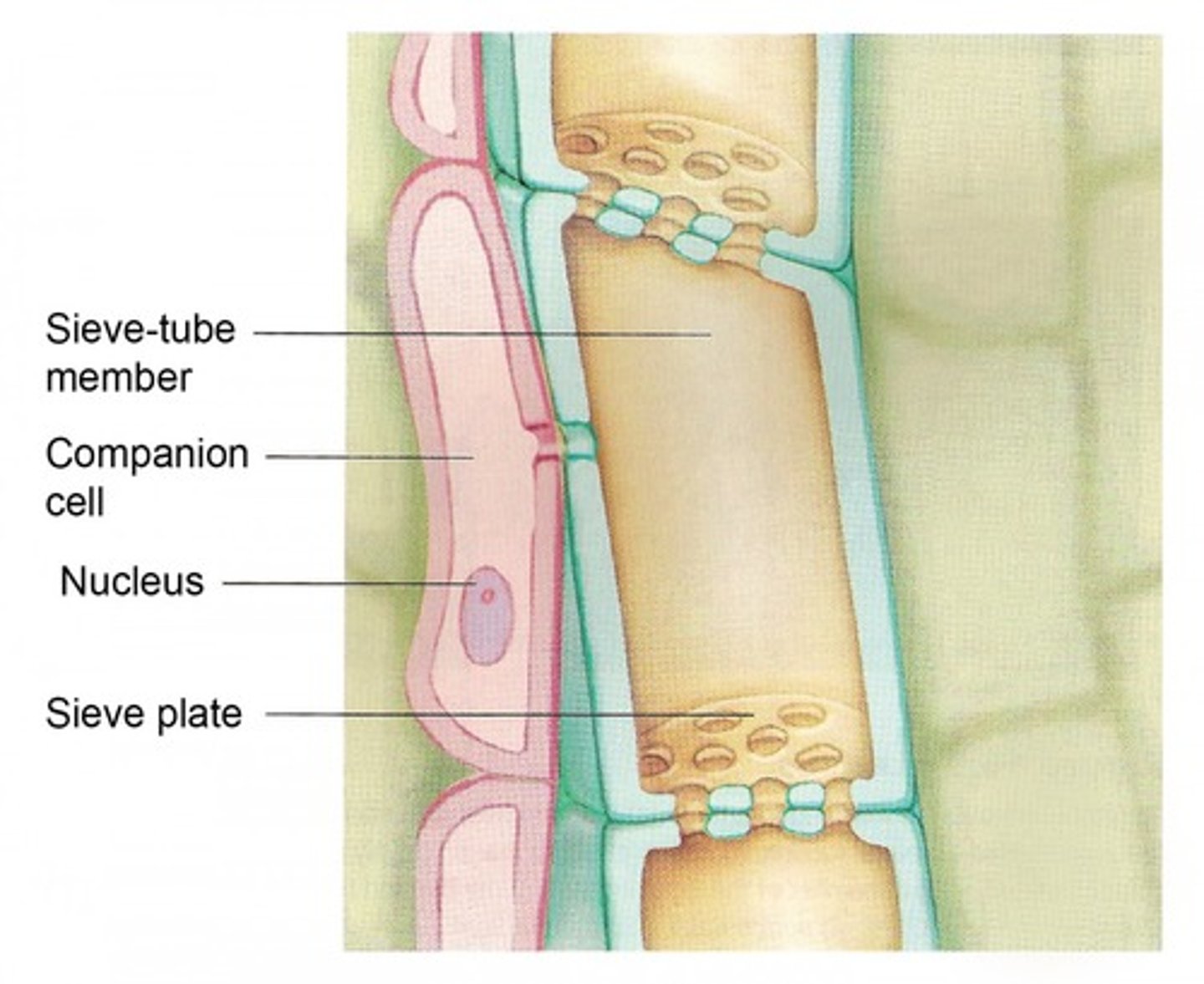
What is the 'pressure flow hypothesis"?
Events at source tissues and sink tissues create a steep pressure potential gradient in phloem. The higher tugor presure caused by water in phloem sap at source moves by bulk flow to a sink; this is the pressure flow mechanism.
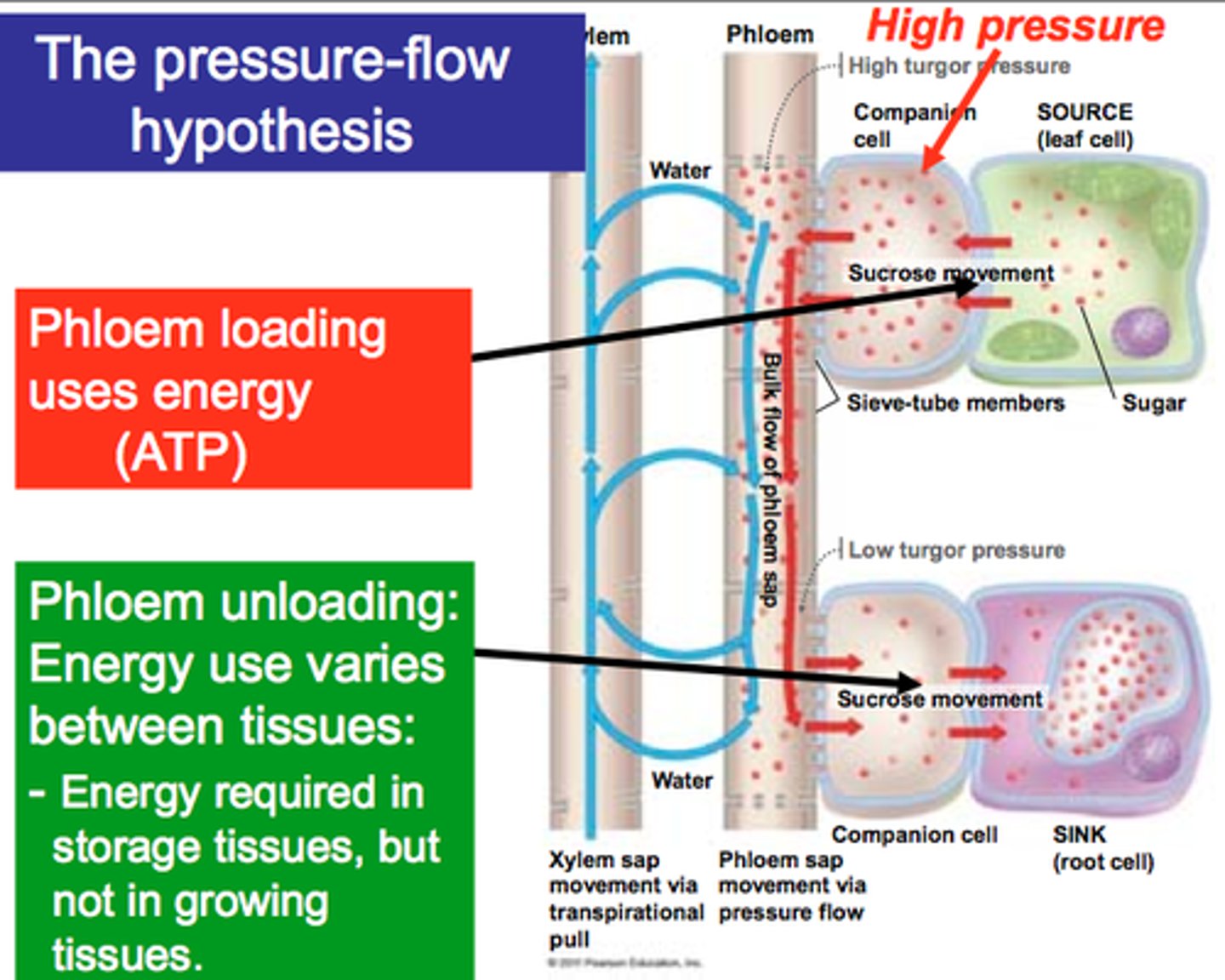
How does the movement of water help the movement of sugars?
Water creates high turgor pressure in phloem near the source and low turgor pressure in the phloem near the sink, created by the unloading of sugars
- This difference in pressure potential drive phloem sap from source to sink via bulk flow
What causes the [gradient] btwn companion cell and parenchymal cells, 2 ways.
1. By actively packing sucrose into a vacuole in the parenchymal cell (Roots do this)
2,. By actively using up sucrose in the parenchymal cell
(Leaves do this)
Phloem loading: What gradients are being created and used here? How are proton pumps used to help transport sugar?
1. Proton pump: pumps H+ from companion cell into source cell to create electrical gradient
2. Cotransporter: Due to high electrical potenial in source cell H+ moves out through a cotransporter, sucrose uses this to move against it's concentration into companion cell.
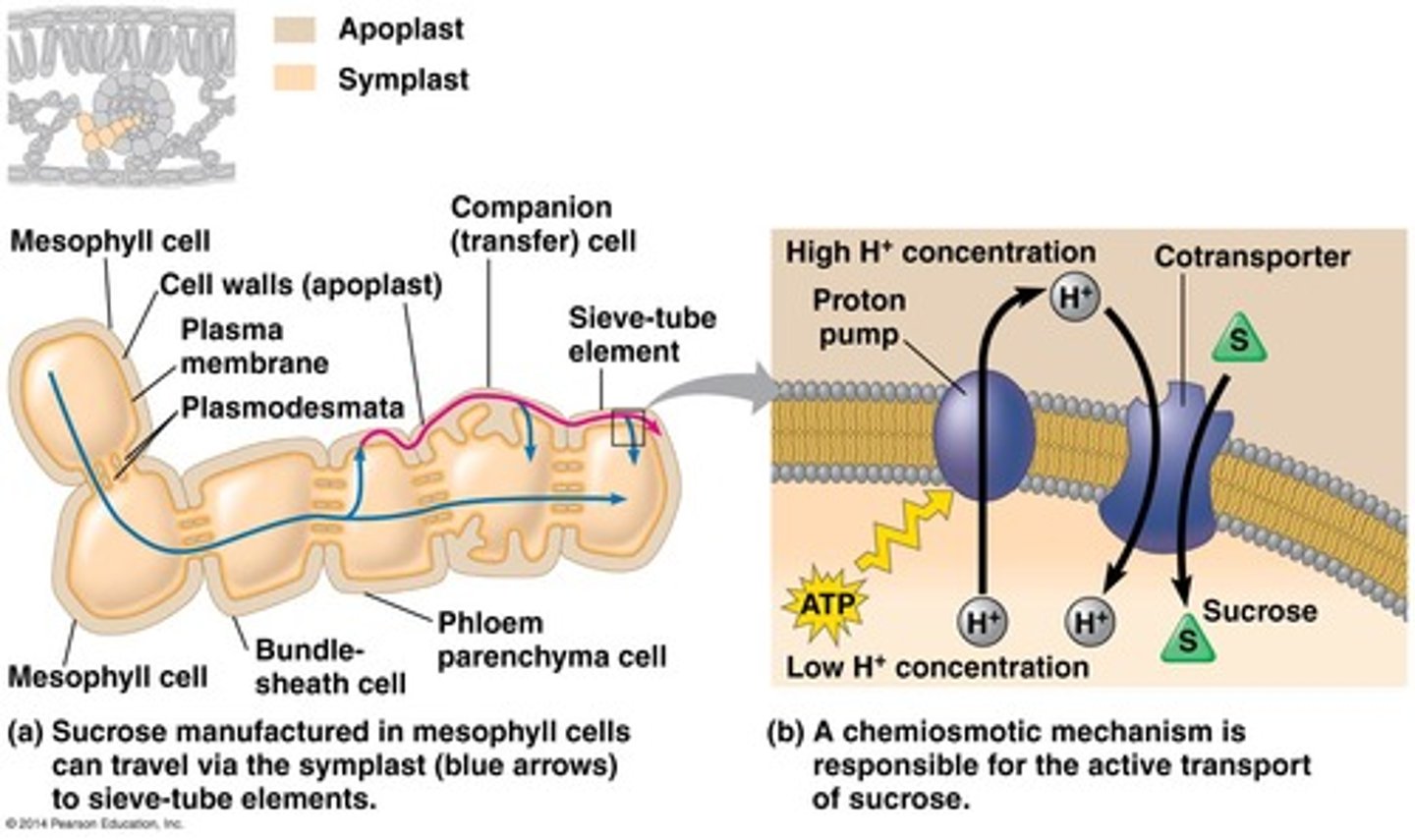
Phloem unloading: What are the two ways that a low sucrose concentration is maintained in sink cell cytoplasm? Why is this important?
1. By actively packing sucrose into vacuoles
2. By actively using up the sucrose
- The reason for this is because a lower concentration is needed in the sink to bring in more sucrose
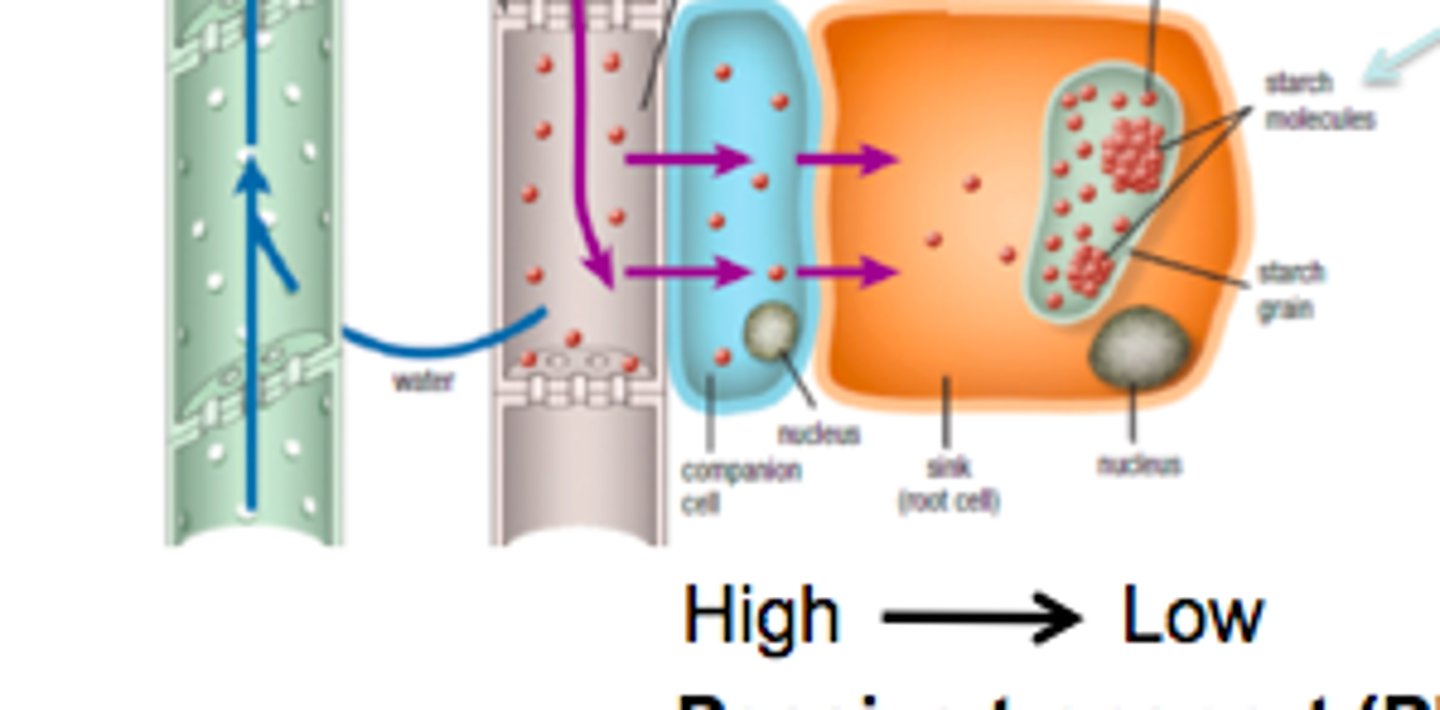
Part 3:
Think about being an oak tree, and what your needs and requirements are for being able to survive for hundreds of years?
Plants have sophisticated systems for collecting information about their environment and responding in ways that maximize their chances of surviving thriving, and producing offspring.
Consider what the plants-equivalent of the human 'five senses' are:
1. Light Detectors- to detect what light they are receiving
2. Pressure- can detect force of wind
3. Gravity- can detect gravity
4. Pain- need it to detect wounds
List the types of environmental signals that plants can respond to and the overall responses:
1. Light: plants detect (blue) light and will tend to shape their body to move toward it, if necessary.
2.
Three steps of information processing in plants
1. Receptor Cell: Perceives external stimulus and transduces the information to an internal signal
2. Hormone(cell-cell signal): released by the receptor cell travels throughout the body
3. Responder cells: receives the hormone signal, transduces it to an internal signal, and changes cell activity
How does Signal transduction change an external signal to internal, in plants?
1. Signal arrives at cell membrane
2. Receptor protein changes in response to signal
3. Receptor catalyzes phosphorylation reaction
4. Phosphorylated protein triggers phosphorylation cascade, or releases messeger
5. Phosphorylated proteins or second messenger initiate cell response
where a plant is responding to an external stimulus.
Overall, how does this process compare to animal cells responding to a hormone?
a. Cell membrane
b. It is similar to that of a membrane protein effect, the protein receptors both change and cause multiple rxns in a cell to produce it's repsonse
What happens when plants receive multiple different hormones carrying different information?
The hormones will interact with each other and modulate the cell's response.
Do most plants have a nervous system?
Plants do not have a nervous system, communicate with other cells via endocrine system
What is:
1. Phototropism
2. Coleoptiles
3. Auxin
1. Directed movement in response to light
2. A modified leaf that forms a sheath protecting the emerging shoots of young grasses
3. A hormone that stimulates phototropism
What kind of light can plants detect?
Blue light, they will move towards it (Phototropsim) when it is present.
- This is the reason why house plants move toward a window
In phototropism, what are the receptor cells?
What is the hormone? What effect does it have on the responder cells?
a. Phototropins, detect blue light
b. Auxin, produced in the tips of coleoptiles
c. Increases the amount of proton pumps on the cells
What does the increase in the amount of proton pumps do to cell?
Acid-Growth:
1. Proton pumps acidify cell wall outside the plasma membrane
2. Walls begin to loosen as activated expansins release molecular links to microfibrils. Electrical gradient brings ions and sugars into cells
3. Water will follow the higher [solutes] now inside the cell and increase tugour pressure. Loosened cell walls are pushed on causing elongation of the cell
What cells elongate on the plant?
- The cells that are shaded.
- By them being elongated the plant will bend towards the light to increase the amount of SA being struck by the sun (light).
What is:
Abscisic acid (ABA)
2. hormone that inhibits growth
Why and when do plants close their stomata?
a. When plants are unable to obtain enough water to replace the fluid being lost at the leaves, stomata close
b. If they didn't continued transpiration would lead to wilting and potential damage
Describe each of the two different mechanisms used to open and to close stomata.
(How are transporters and electrochemical gradients involved?)
1. Stomata open in response to blue light
1. Blue light strikes photoreceptor, proton pumps pump out H+
2. K+ and Cl- enter cell via electrochemical gradient using cotransporter for H+
3. H20 follows ions into cell
4. Cell swells (become turgid) and stomata opens
2. Stomata close in response to ABA
1. ABA bind to receptor on guard cell, proton pump stops working. Cl- begins to flow out of cell along electrochemical gradient
2. K+ exits along electrochemical gradient
3. H20 follows ions out of cell
4. Cell shrinks, closing stomata
What is:
1. Senescence
2. Ethylene
1. Process of aging and eventual death of an organism
2. Hormone that regulates senescence
How could same cells be sensitive or insensitive to ethylene at different times?
a. Different receptors- these receptors change based on the time of year
How does ethylene get into the cell?
It is a gas at normal temp. and can
What is 'abscission'?
- The senesce of leaves, detaching and falling.
- Ethylene weakens the cell walls near the base of the petiole called the abscission zone.
- All the nutrients exit the leaf into a sink
How is it possible for a single hormone to affect many different target tissues?
a. They have receptors that
Why is defence particularly important for plants?
Plants are stationary and cannot run away in the face of danger. They are forced to stand and fight.
What are secondary metabolites, and how are they used in defense
- a defence molecule
- they poison herbivores
a. peppermint, lemom, & basil repel insects
b. opium, caffeine, & THC disrupt nervous systems of animals
Describe the mechanism of how systemin functions;
what is the main purpose of this process?
- it is a wound-response hormone, released from damaged cells
a. hormone binds to undamaged cells and causes synthesis of jasmonic acid
b. Jasmonic acid activates production of gene products (ex. proteinase inhibitors)
c. herbivore then eats this insecticide
How, in general, can plants recruit help from other plants or insects?
Plants can release pheromones that recruit help from wasps to attack caterpillars